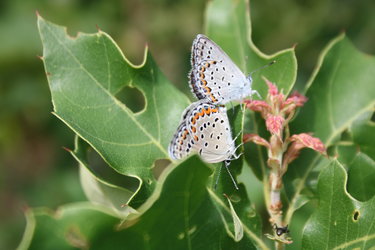Mapping Guilderland’s future, planners urge defining the town’s character and being mindful of biosolids
The Enterprise — Michael Koff
Karner blue butterflies perch on a plant along the Truax Barrens Trail in the pine bush to mate. When they open their wings, males are blue and females are brown. The Karner blue — which had lost 99 percent of its population when it was protected as endangered over three decades ago but is making a comeback in the Albany Pine Bush — has become a symbol for environmental preservation. Advocates for the globally rare pine barrens told the Guilderland Town Board this month more protection for the pine bush is warranted in the updated comprehensive plan.
GUILDERLAND — Residents who spoke on July 15 about the latest iteration of Guilderland’s Comprehensive Plan update felt the plan did not say enough about preserving the Albany Pine Bush, but said too much about providing water to Altamont.
The update to the plan incorporated recommendations from the town’s planning board. Among the major additions were an acknowledgement of recent concerns in Albany County about spreading sewer sludge on farms and what the town should do in response to the issue, and a large section at the start of the plan describing the town’s character and what should be done to preserve it.
The addition to the update states that town character “refers to the unique set of qualities and attributes that define a town, shaping its identity and atmosphere. It’s the collective impression a place makes on residents and visitors, influenced by factors such as architecture, natural features, history, culture, and the way people interact within the community. Essentially, it’s what makes a town feel distinct and memorable.”
At a March 18 public hearing on the updated plan, Laurel Bohl, a former town councilwoman, had pushed for including a section on town character.
The planning board’s addition focused on several key objectives to protect and enhance Guilderland’s character:
— Preserve existing character: Safeguard the unique architectural styles, historic buildings, and natural landscapes that are central to the town’s identity;
— Guide future development: Ensure new development aligns with the town’s desired character through architectural guidelines and the preservation of open spaces;
— Promote walkable neighborhoods: Encourage pedestrian-friendly streets, mixed-use development, and easy access to amenities to strengthen the sense of community;
— Protect natural resources: Safeguard environmentally sensitive areas, open spaces, and recreational opportunities that are vital to the town’s character and quality of life;
— Balance growth and preservation: Manage new growth so it doesn’t overwhelm the town’s existing character or diminish its unique qualities; and
— Enhance community identity: Strengthen the town’s identity through public art, cultural events, and other initiatives that celebrate its history and culture.
A recent concern in Albany County has been the use of biosolids on a New Scotland farm and its potential impact on drinking water. Biosolids, a byproduct of treated wastewater, have been shown to contain cancer-causing compounds. In response, the planning board recommends the town should:
— Review existing Watervliet Reservoir and watercourse setbacks in the town’s zoning law to determine if it provides adequate protection;
— Evaluate existing permitted uses, site-plan uses, and special uses in the zoning law to determine if additional protection measures are necessary for the Watervliet Reservoir and its major watercourses;
— Implement recommendations from the Watervliet Reservoir Drinking Water Source Protection Plan;
— Adopt agricultural best-management practices to protect the reservoir, its tributaries, and other watercourses; and
— Coordinate with Schenectady County to ensure the reservoir watershed, upstream from the reservoir, is adequately protected.
Pine Bush
Lynne Jackson, a volunteer with and a founder of Save the Pine Bush, articulated several concerns related to the plan’s current treatment of the Pine Bush ecosystem.
Jackson said that the plan update lacks sufficient detail and emphasis on the Pine Bush. “There’s not enough written about this really valuable resource,” Jackson said, adding that she hoped that the final plan would “add a lot more about the Pine Bush.”
She elaborated on the unique and irreplaceable value of the Pine Bush, “the world’s best remaining example of an inland pitch-pine scrub-oak barren.” She further noted its role in supporting “69 wildlife species of greatest conservation need, including the Karner blue butterfly.”
Geologically, Jackson said, the Pine Bush stands as “the largest inland sand dune system in eastern North America,” and went on to cite its numerous official designations, including its “national natural landmark” status and it being a “national heritage area site” as well as a “New York State Bird Conservation Area” and a “National Audubon Society important bird area.”
Jackson said that the Pine Bush “is currently being eaten away a few acres at a time.” This incremental loss, she argued, threatens the long-term viability of the ecosystem, which Jackson said “is not going to be able to survive unless all of the currently designated full and partial protection areas in the Albany Pine Bush Management Plan are preserved.”
In response to a question from Councilwoman Amanda Beedle about what it would cost Guilderland to buy up the remaining Pine Bush land in town, Jackson, who later admitted she did not know the cost, elegantly sidestepped and refocused the question, stating, “There’s the cost of actually purchasing the land. But there’s also the cost of not preserving the land in terms of preserving this really invaluable source.”
Supervisor Peter Barber, in response to Jackson’s comments as well as those from other members of the not-for-profit advocacy organization, said, “I agree that we need to have probably a section just devoted to the Pine Bush.”
Water
As one of the only municipalities in Albany County not connected to a neighboring watersource, the village of Altamont is now attempting to remedy that shortcoming.
Altamont actually has two water problems it is looking to address:
— Manganese issues with its Brandle Road wellsite so it can be used on a regular basis, and rotating with Gun Club Road’s wells; and
— Establishing an emergency interconnect with Guilderland to safeguard the Altamont community, as well as the village’s outside water customers, in the case of a water emergency.
Robyn Gray, who chairs the Guilderland Coalition for Responsible Growth, raised a question regarding the level of detail in the plan’s recommendation as it pertained to Altamont’s water issue.
The plan generally recommends that Guilderland should support Altamont’s “efforts to implement an interconnection between the water districts to improve the Village’s water security. It remains important to focus on water and sewer capacity improvements to support traditional population centers in Town.”
An addition states, “To improve water security and reliability in and around the Village of Altamont, the Village should consider options for redundancy in water sources. This could be in the form of determining if constructing a new water well is feasible, or if a water line extension is feasible.
“If a waterline extension is the most feasible option, the closest waterline is at the intersection of NYS Route 146 and NYS Route 158 in Guilderland Center. A waterline extension from this intersection and along the NYS Route 146 corridor to Armstrong Drive in Altamont is approximately 1.2 miles. The Village would be the lead agency in the design, construction, and funding of any waterline extension.”
Gray’s concern centered on the notion that such a granular specification within the plan was inappropriate and potentially counterproductive to the town’s broader objectives.
Is it “appropriate to go into this much detail in a comprehensive plan?” Gray asked, stating, “I thought that was a bit over the top.”
By outlining specific infrastructure plans and potential expansion corridors, Gray said the level of detail in the recommendation provided a “blueprint for developers” in areas that the town might otherwise seek to protect or manage with greater discretion.
At the March 18 hearing on the plan update, David Bourque, president of Historic Altamont, said that the not-for-profit group supports the plan’s recommendation to incorporate the Helderberg escarpment viewsheds into permit reviews.
“This will strongly help the Helderberg Greenway that The Enterprise has been reporting on for several years now with the whole goal of creating a green belt around Altamont to save the rural character, not let it be suburbanized,” said Bourque.
Barber responded that the town would proceed with creating an overlay district to protect the Helderberg viewshed whether or not it gets applied-for state funding.
On July 15, Gray also told the town board that there was a discrepancy between the detailed language recommendation and a June resolution concerning supplying water to Altamont, which said the interconnect would be used “in the event of an emergency or as a back-up,” not as a regular supply. Mayor Kerry Dineen previously told The Enterprise that the interconnect would be for emergency use only.
In response to Gray’s critique, Councilwoman Christine Napierski said, “I thought this was a controversial issue, and I thought there were residents in Altamont that did not want that because then all the development will come in.”
Napierski, referring to an earlier comment made by Gray about it sounding like it was a “done deal” that Guilderland would be providing a regular supply of water to Altamont, said the recommendation “made me question it too.”
Barber said, “I think what we’ll probably do is take a look at the resolution and try to match it as much as possible.”


